Junqing Chen
Implicit Neural Shape Optimization for 3D High-Contrast Electrical Impedance Tomography
May 22, 2025Abstract:We present a novel implicit neural shape optimization framework for 3D high-contrast Electrical Impedance Tomography (EIT), addressing scenarios where conductivity exhibits sharp discontinuities across material interfaces. These high-contrast cases, prevalent in metallic implant monitoring and industrial defect detection, challenge traditional reconstruction methods due to severe ill-posedness. Our approach synergizes shape optimization with implicit neural representations, introducing key innovations including a shape derivative-based optimization scheme that explicitly incorporates high-contrast interface conditions and an efficient latent space representation that reduces variable dimensionality. Through rigorous theoretical analysis of algorithm convergence and extensive numerical experiments, we demonstrate substantial performance improvements, establishing our framework as promising for practical applications in medical imaging with metallic implants and industrial non-destructive testing.
Neumann Series-based Neural Operator for Solving Inverse Medium Problem
Sep 14, 2024



Abstract:The inverse medium problem, inherently ill-posed and nonlinear, presents significant computational challenges. This study introduces a novel approach by integrating a Neumann series structure within a neural network framework to effectively handle multiparameter inputs. Experiments demonstrate that our methodology not only accelerates computations but also significantly enhances generalization performance, even with varying scattering properties and noisy data. The robustness and adaptability of our framework provide crucial insights and methodologies, extending its applicability to a broad spectrum of scattering problems. These advancements mark a significant step forward in the field, offering a scalable solution to traditionally complex inverse problems.
Leveraging Label Information for Multimodal Emotion Recognition
Sep 05, 2023Abstract:Multimodal emotion recognition (MER) aims to detect the emotional status of a given expression by combining the speech and text information. Intuitively, label information should be capable of helping the model locate the salient tokens/frames relevant to the specific emotion, which finally facilitates the MER task. Inspired by this, we propose a novel approach for MER by leveraging label information. Specifically, we first obtain the representative label embeddings for both text and speech modalities, then learn the label-enhanced text/speech representations for each utterance via label-token and label-frame interactions. Finally, we devise a novel label-guided attentive fusion module to fuse the label-aware text and speech representations for emotion classification. Extensive experiments were conducted on the public IEMOCAP dataset, and experimental results demonstrate that our proposed approach outperforms existing baselines and achieves new state-of-the-art performance.
BI-GreenNet: Learning Green's functions by boundary integral network
Apr 28, 2022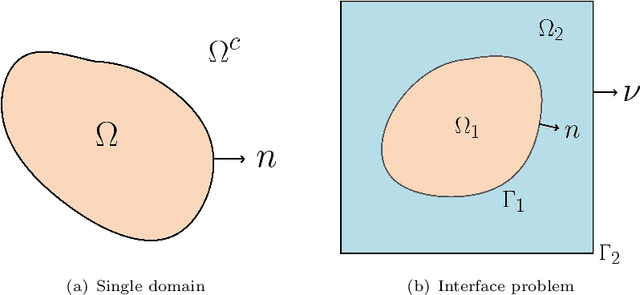
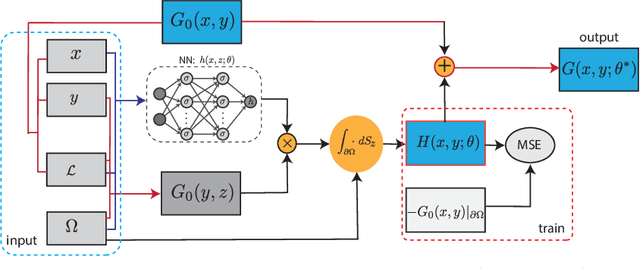

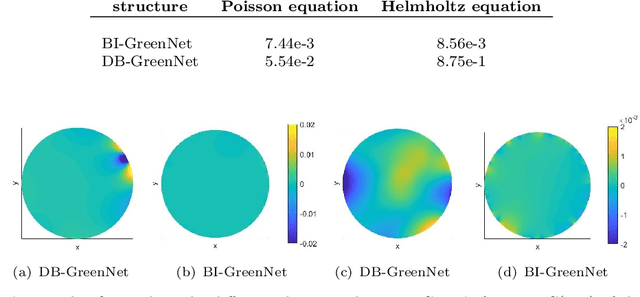
Abstract:Green's function plays a significant role in both theoretical analysis and numerical computing of partial differential equations (PDEs). However, in most cases, Green's function is difficult to compute. The troubles arise in the following three folds. Firstly, compared with the original PDE, the dimension of Green's function is doubled, making it impossible to be handled by traditional mesh-based methods. Secondly, Green's function usually contains singularities which increase the difficulty to get a good approximation. Lastly, the computational domain may be very complex or even unbounded. To override these problems, we leverage the fundamental solution, boundary integral method and neural networks to develop a new method for computing Green's function with high accuracy in this paper. We focus on Green's function of Poisson and Helmholtz equations in bounded domains, unbounded domains. We also consider Poisson equation and Helmholtz domains with interfaces. Extensive numerical experiments illustrate the efficiency and the accuracy of our method for solving Green's function. In addition, we also use the Green's function calculated by our method to solve a class of PDE, and also obtain high-precision solutions, which shows the good generalization ability of our method on solving PDEs.
M2N: Mesh Movement Networks for PDE Solvers
Apr 24, 2022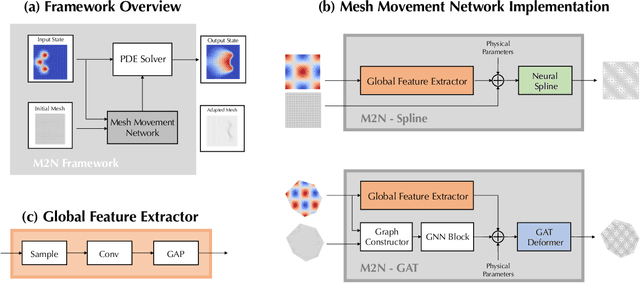
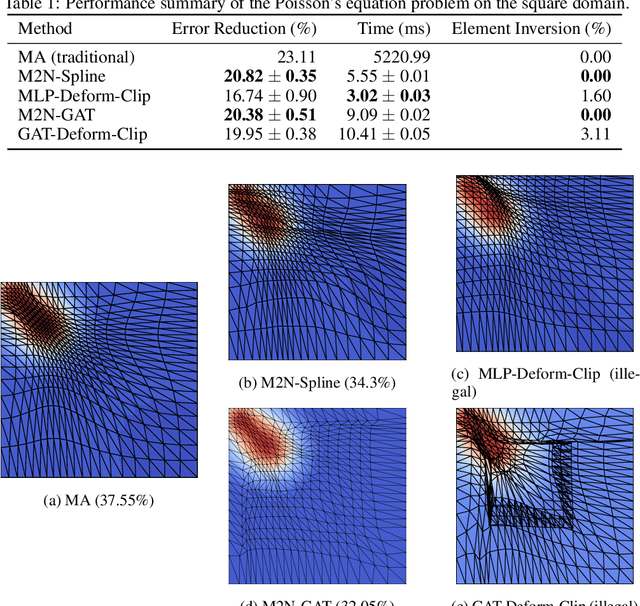

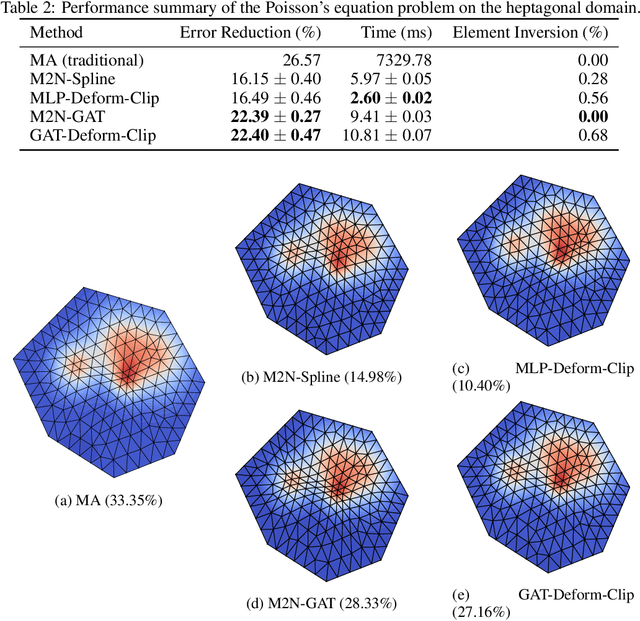
Abstract:Mainstream numerical Partial Differential Equation (PDE) solvers require discretizing the physical domain using a mesh. Mesh movement methods aim to improve the accuracy of the numerical solution by increasing mesh resolution where the solution is not well-resolved, whilst reducing unnecessary resolution elsewhere. However, mesh movement methods, such as the Monge-Ampere method, require the solution of auxiliary equations, which can be extremely expensive especially when the mesh is adapted frequently. In this paper, we propose to our best knowledge the first learning-based end-to-end mesh movement framework for PDE solvers. Key requirements of learning-based mesh movement methods are alleviating mesh tangling, boundary consistency, and generalization to mesh with different resolutions. To achieve these goals, we introduce the neural spline model and the graph attention network (GAT) into our models respectively. While the Neural-Spline based model provides more flexibility for large deformation, the GAT based model can handle domains with more complicated shapes and is better at performing delicate local deformation. We validate our methods on stationary and time-dependent, linear and non-linear equations, as well as regularly and irregularly shaped domains. Compared to the traditional Monge-Ampere method, our approach can greatly accelerate the mesh adaptation process, whilst achieving comparable numerical error reduction.
DialogXL: All-in-One XLNet for Multi-Party Conversation Emotion Recognition
Dec 16, 2020


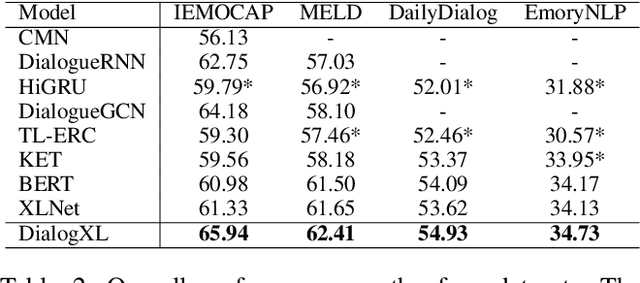
Abstract:This paper presents our pioneering effort for emotion recognition in conversation (ERC) with pre-trained language models. Unlike regular documents, conversational utterances appear alternately from different parties and are usually organized as hierarchical structures in previous work. Such structures are not conducive to the application of pre-trained language models such as XLNet. To address this issue, we propose an all-in-one XLNet model, namely DialogXL, with enhanced memory to store longer historical context and dialog-aware self-attention to deal with the multi-party structures. Specifically, we first modify the recurrence mechanism of XLNet from segment-level to utterance-level in order to better model the conversational data. Second, we introduce dialog-aware self-attention in replacement of the vanilla self-attention in XLNet to capture useful intra- and inter-speaker dependencies. Extensive experiments are conducted on four ERC benchmarks with mainstream models presented for comparison. The experimental results show that the proposed model outperforms the baselines on all the datasets. Several other experiments such as ablation study and error analysis are also conducted and the results confirm the role of the critical modules of DialogXL.
 Add to Chrome
Add to Chrome Add to Firefox
Add to Firefox Add to Edge
Add to Edge